Introduction: Strenuous diaphragmatic contraction associated with loaded breathing induces an inflammatory response observed both within the diaphragm (1) and systematically (2). ROS production increases (3) whereas NO production decreases (4)in the diaphragm in response to acute resistive breathing. Methods: Anesthetized (ketamine 100mg/kg ip), tracheostomized, spontaneously breathing female adult wistar rats were subjected for 6 hours to moderate inspiratory resistive loading (50% of the maximum inspiratory pressure)(1, 4). Based on the IRL protocol two independent set of experiments performed: 1) rats undergoing IRL with the pre-treatment (RB-LN) or not (RB) of the non-selective NOS inhibitor L-NAME (100mg/kg/3h), 2) IRL rats treated with: a) vitamin C (RB-vC), 500mg/kg, b) vitamin A (RB-vA), 195mg/kg, c) N-Acetyl-L-cysteine (RB-NAC), 1gr/kg, d) oxypurinole (RB-oxp), 50mg/kg. All drugs were administered ip 30 min before the initiation of IRL (for oxp an additional treatment the day before, 50mg/kg/12h, was performed. Immediately after the 6h IRL the diaphragm was excised and cytokine protein expression was analysed with ELISA (RnD Systems). Sham-operated rats pretreated with either saline or the respective drugs were studied as control (Ctr). All statistical correlations were performed by Mann-Whitney analysis. Results The cumulative ELISA results are presented in Table 1. Blockage of NO production with L-NAME administration resulted in augmentation of the IRL-induced cytokines production within the diaphragm (RB-LN vs RB, p<0.05 and RB vs Ctr, p<0.05). NAC pre-treatment of the rats undergoing IRL, caused a statistically significant intra-diaphragmatic reduction of IL-6, TNF-a and IL-1b (for all correlations p<0.05) whereas, vitamin A administration resulted in a similar reduction of IL-1b and a borderline decrease in TNF-a (p=0.056). Furthermore, oxypurinol treatment reduced only TNF-a production in the diaphragm of both control (p<0.05) and RB animals (p<0.05). In contrast, administration of vitamin C did not affect cytokine production at all. Conclusions 1) Inhibition of endogenous NO synthesis resulted in significant elevation of cytokines (IL-6, IL-1b, IL-10, TNF-a) expression in the diaphragm of rats exposed to moderate inspiratory resistive loading. 2) Antioxidant treatment modifies intra-diaphragmatic resistive breathing induced cytokine expression.
University of Cambridge (2008) Proc Physiol Soc 11, PC125
Poster Communications: Cytokine expression in the diaphragm in response to acute resistive loading: Regulation by Nitric oxide and oxidative stress.
G. Sigala1,2, P. Zacharatos1,2, T. Michailidou2, S. Mpoulia1,2, L. Tsaprouni2, N. Passiotis2, A. Makris2, M. Makropoulou2, E. Markozanes1,2, D. Parthenis2, A. Papapetropoulos2, C. Roussos1,2, S. A. Hussain3, T. Vassilakopoulos1,2
1. Department of Critical Care and Pulmonary Services, University of Athens Medical School, Evangelismos Hospital, Athens, Greece. 2. Thorax Foundation, Athens, Greece. 3. Critical Care and Respiratory Divisions and Meakins-Christie Laboratories, Department of Medicine, McGill University Health Centre, Montreal, Québec, Quebec, Canada.
View other abstracts by:
Where applicable, experiments conform with Society ethical requirements.

